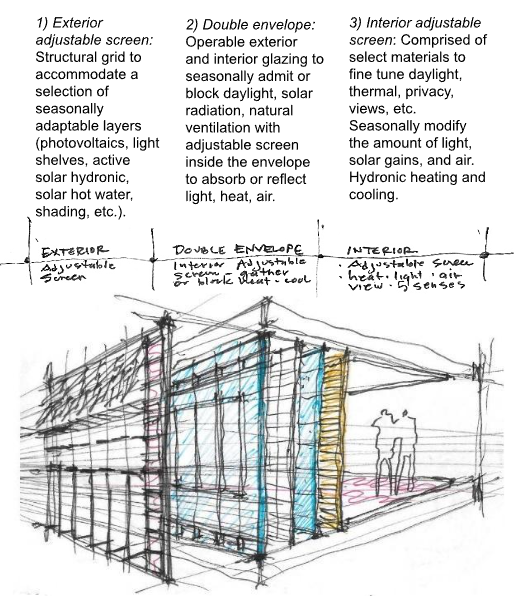"Nature is the best designer." - Somali K. Chakrabarti
What does it mean to "Test and Revisit the Challenge"?
The sixth step revisits the original design challenge to clarify the design intentions and to refine design criteria to evaluate conceptual design scenarios. Develop a prototype and use it to refine, through iterations and explorations, the relationships and impacts across scales. Consider how the solutions interact with real world conditions, as well as how the solutions impact other design issues. The iterative design process can be repeated as needed with parallel questions (how nature cools in summer) and other related issues (envelope design for lighting, moisture, energy performance, etc.). Conceptual design scenarios can be further developed through the lens of select design and performance metrics.

How do you "Test and Revisit the Challenge"?
In the cold-climate, south-facing envelope example, the attributes of the penguin feathers and the vascular system of the wings informed a layered and integrated passive-active hybrid approach to the conceptual design (see Figure 10 and the following discussion).
First, the feathers inspired the concept of three adjustable louvered structures from outside to inside (Figure 10):
1) An exterior adjustable screen (to provide a range of functions that might include integrated shading, solar control, lightshelves, photovoltaics, rainscreen, active solar collectors, rain collection, etc.), 2) A double envelope with operable interior and exterior glazing with an adjustable interior screen (to further modify material attributes seasonally or diurnally to absorb or reject heat, light, air, etc.), and 3) An interior adjustable screen (to fine tune views, sound, sensory experiences, privacy, biophilic connections, etc.).
Second, the penguin wings and vascular system (heat exchanger) informed the conceptual development of a double envelope for seasonal passive heating and cooling integrated with active hydronic solar heating (Figure 10). Developing and testing this concept design requires further exploration of seasonal strategies for staying cool, including the integration of natural ventilation, solar control, and daylighting with passive and active strategies for winter. The designer would then repeat the bio-inspired design process, for instance studying how birds stay cool during the summer in part by holding their feathers in ways to trap less air or incorporating butterfly-wing-inspired structural materials that would absorb more warmth during the winter. The steps below illustrate the conceptual design process.
Step 6 Example: Revisit Design Challenge
- Evaluate conceptual designs based on design criteria: Identify most-promising design scenarios based on design criteria. Further develop scenarios based on design and performance criteria across time and seasons.
- Revisit larger questions (broad vs narrow): Repeat iterative process for parallel questions and integrate: How does nature stay cool, how does nature illuminate, stay dry, respond to dynamic conditions, etc.?
- Repeat parallel design iterations: Determine which design concepts to develop and integrate across seasons and/or other design considerations.
- Select scenarios for evaluation: Move forward with select scenarios to evaluate using qualitative and quantitative design criteria, assessment tools, and metrics.